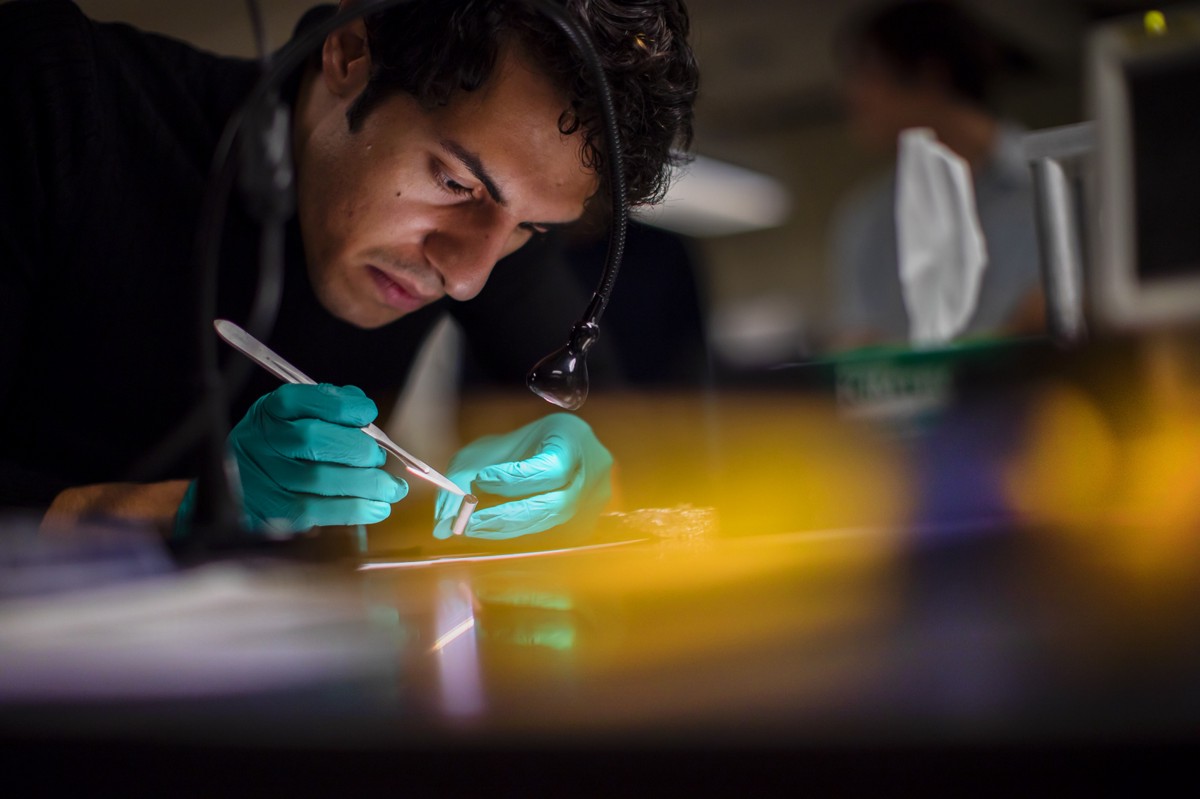A New Way to Fly, Built Up From the Nanoscale
Super-thin ‘nanocardboard’ can levitate using only the power of light, opening the door to tiny flying machines with no moving parts.

By Gwyneth K. Shaw
Take a sheet of paper and blow on it. What happens? It might soar very briefly, but quickly flops back down, the air you’re expelling blowing around and through it.
Now, think about an ultra-light material that’s stiff enough to sustain that lift, but light enough that an amazingly small amount of energy — just a beam of light — can make it rise.

Inside mechanical engineer Igor Bargatin’s lab, this possibility is reality. After years of work and refinement, he and his team have developed what they call “nanocardboard,” a material that’s as thin as a few strands of DNA and weighs less than a thousandth of a gram, but stiff enough to resist flopping.
“What we have here is actually a composite of solid and empty space. We’re specifically putting the solid material only in places where it matters the most and take the advantage of the weightless empty space,” says Sam Nicaise, a postdoctoral researcher in Bargatin’s lab.
Over the past few years, Bargatin and researchers in his lab have been working on these plate mechanical metamaterials: Structures that are super thin, perhaps just a few tens of nanometers, but big enough that you can hold them in your hands. The nanocardboard breakthrough was published in Nature Communications last year.
As they honed their materials, they realized that the very lightness of the material opened the door to light-driven movement — initially, just brief levitation but eventually, perhaps, sustained controlled flight. Bargatin just received a prestigious CAREER Award from the National Science Foundation to pursue this tantalizing possibility.
Bargatin was inspired by a simple instrument that’s been around for more than a century, a device known as a Crookes radiometer. (You may have had one in your house as a kid or seen one in a glassblower’s shop.) Also known as a light mill, the instrument is essentially a glass bulb under partial vacuum with paper vanes that are black on one side and white on the other.
When the radiometer is exposed to sunlight, the black sides of the vanes absorb some of the energy and heat up a little bit.
“What’s happening then is the air molecules hit the black side, absorb some of the heat, and then leave with a higher speed than it came in with. In physics, we know that whenever you have a change of momentum, or speed, there must be a recoil, there must be a reaction force. The recoil pushes harder on the hotter black sides than the cooler white sides of the vanes and can make the Crookes radiometer rotate pretty quickly if you put it out in direct sunlight,” Bargatin says.
“Sometimes people think that the Crookes radiometer is driven by light pressure,” he adds. “The light pressure is obviously there, but it is much smaller and points the opposite way. The force that we observe and use is a thermal effect, based on the interaction between the gas molecules and a heated solid.”
Although the Crookes radiometer has been around for more than a century, no one has yet been able to use these forces to overcome gravity and make the vanes levitate. That’s where the new nanocardboard plates come in. Because they’re so light, thermal forces that are too small to lift paper can lift the nanocardboard pieces into the air.
“It’s exciting because it’s essentially a new mechanism of flight,” Bargatin says. “We’re talking about a structure half an inch in size that can fly around without any moving parts. These structures create a jet of air and a corresponding lift force, just based on the temperature differences that exist in the structure.
“The most exciting thing is thinking about how far we can push it in terms of payloads and dreaming about what else we could do.”
The possibilities are dazzling. Using light, whether it’s sunlight or a laser beam, to power a flying device opens the door to a huge range of potential uses.
For about 20 years, academics have explored the concept of “smart dust”: ultra-small particles that can work as sensors, measuring temperature, pressure, and more.
Imagine a search and rescue operation using “microflyers” that could dart in and out of tiny holes in the rubble, to help find trapped people without putting first responders at risk. Or a tiny robot with a camera that could inspect a jet engine for wear and other problems without taking the engine apart.
Continue reading at Penn Today.

